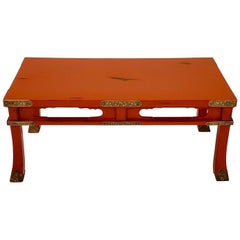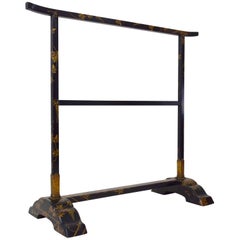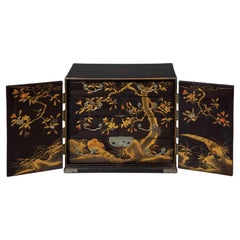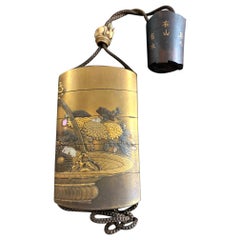R. Louis Bofferding Decorative and Fine Art Lacquer
to
2
2
1
1
1
1
1
1
1
2
2
2
2
2
2
18th Century Japanese Altar Table
Located in New York, NY
This lacquered 18th century Edo period altar table was probably made for the private shrine of an aristocratic home. There, it would have been placed before an image of a deity, and ...
Category
Antique Early 18th Century Japanese Edo Lacquer
Materials
Brass
Elegant Japanese Edo Period Rack
Located in New York, NY
This refined object dates to the first half of the 19th century, and was probably used for obi, kimono sashes, which were hung over it. The gold decorations on the black-lacquered g...
Category
Antique 1830s Japanese Edo Lacquer
Materials
Lacquer
Related Items
19th Century Japanese Lacquer Table Cabinet
Located in Richmond, London
A fine and rare Japanese black lacquer table or jewellery cabinet, exquisitely decorated in intricate detail, dating to the late Meiji per...
Category
Antique Late 19th Century Japanese Meiji Lacquer
Materials
Metal
Antique Japanese Inro by Shigehide Edo Period
Located in Atlanta, GA
This exquisite four-case lacquered inro was dated to the latter part of 18th century to early 19th century (Edo period) and made by Shigehide. The opposite sides of the inro together features a lavish flower arrangement in a bamboo basket (ikebana). The detailed craftmanship was a true pleasure to behold. Mostly Takamaki-e (high relief) were used to texturize the delicate petals of the chrysanthemums, on which different shades of gold were used to create contrast. Raden (mother of pearl) shells were also used to highlight some leaves, rendering the piece an interesting balance of color and material. The interior was completed in a mottled gold finish. It was signed Shigehide on the bottom with a Kao. There is a small carved rabbit ojime bead...
Category
Antique Late 18th Century Japanese Japonisme Lacquer
Materials
Wood, Lacquer
Japanese Momoyama Period Black Lacquer and Mother of Pearl Box, 16th Century
Located in Austin, TX
A fine and unusual Japanese black lacquer and mother of pearl inlaid box, Momoyama Period, 16th century, Japan.
The large box and cover featu...
Category
Antique 16th Century Japanese Edo Lacquer
Materials
Lacquer, Abalone
Japanese Samurai Abumi Stirrups Lacquer Edo, 18th Century
Located in Dallas, TX
Japanese Samurai Abumi Stirrups lacquer Edo late 18th century, early 19th century.
Measures: 12 inch length, 10 inch height, 5.5 inch width.
AVANTIQUES is dedicated to providing an...
Category
Antique Late 18th Century Japanese Edo Lacquer
Materials
Iron
Japanese Lacquer Smoking Box, Tabako Bon, Edo Period, 19th Century
Located in Austin, TX
A very fine Japanese maki-e lacquer decorated tabako bon, or smoking box, late Edo Period, mid-19th century, Japan.
The elegant smoking box of black lacquer decorated with a wonderful gold lacquer takamaki-e design of a gnarled and elegantly twisted plum tree with branches in full bloom. A border of golden cranes in flight to the top.
The smoking box, called a tabako bon, is comprised of an open section at the top with inset with two cylindrical metal canisters...
Category
Antique Mid-19th Century Japanese Edo Lacquer
Materials
Lacquer
Japanese Lacquer and Cinnabar "Samurai" Cabinet, Inaba Family, Edo Period
Located in Troy, NY
Exceptionally large and rare lacquer cabinet. According to the heraldry, visible on the headgear in one of the panels, it was made for the Inaba family, a high ranking Daimyo family,...
Category
Antique Late 19th Century Japanese Edo Lacquer
Materials
Wood
Japanese Lacquer Incense Accessories Box, Kobako, Edo Period, mid 19th c, Japan
Located in Austin, TX
A remarkable Japanese maki-e lacquer box for incense accessories, kobako, with interior fitted tray, kakego, designed with a temple complex scene, late Edo Period, mid 19th century, ...
Category
Antique Mid-19th Century Japanese Edo Lacquer
Materials
Silk, Softwood, Cypress, Lacquer
H 3.75 in W 7.25 in D 5.5 in
Japanese Lacquer Incense Burner, Koro, Edo period, mid 19th century, Japan
Located in Austin, TX
An elegant and refined Japanese lacquer koro, incense burner, in the form of a chaire, tea caddy, Edo Perio, mid 19th century, Japan.
The barrel shaped koro formed as a traditional ...
Category
Antique Mid-19th Century Japanese Edo Lacquer
Materials
Copper
Antique 18th Century Export Chinese Lacquer Gaming Box
Located in Brea, CA
Antique 18th century export Chinese lacquer gaming box with hand painted scenes gilt export black lacquer, there are 7 gaming boxes and 12 trays, size: ...
Category
Antique Late 18th Century Chinese Qing Lacquer
Materials
Lacquer
17th Century Japanese Export Lacquer Cabinet with Depiction the Dutch Tradepost
Located in Amsterdam, NL
A highly important Japanese export lacquer cabinet with depiction of the Dutch East India Company tradepost Deshima and the annual Dutch delegation on its way to the Shogun in Edo
Edo period, circa 1660-1680
H. 88 x W. 100.5 x D. 54 cm
This cabinet includes a later European japanned stand, but also a modern powder-coated steel frame.
The latter can be designed and added to your specific needs.
The sides and front of the rectangular two-door cabinet are embellished in gold and silver hiramaki-e and takamaki-e on a black roiro lacquer ground with a continuous design. The two doors depict a long procession of numerous figures travelling on foot and horseback along buildings and a pagoda into a mountainous landscape. This is the annual court journey, Hofreis, of the Dutch from Nagasaki to the Shogun’s court in Edo. Three horseback riders are dressed as Dutch merchants and a fourth figure, probably het Opperhoofd, is seen inside a palanquin, norimon. Just about to cross the bridge, two men are carrying a cabinet like the present one.
Many Japanese figures on either side of the procession are engaged in various activities; some play musical instruments on board of small boats, others are fishing; figures inside buildings are depicted playing go, and farmers are tending to their rice paddocks. The upper part of the right door shows a large mansion, probably the local daimyo’s castle, with men kneeling before a man in the central courtyard.
The court journey fits in with the foreign policy of the shogunate which accorded a role to the VOC alongside China, Korea, and the Ryukyu Islands who also had to pay tribute. However, the VOC employees were traders, having low status in Japan’s social hierarchy, and they were received with less deference than were the state embassies from Korea and the Ryukyu Islands. Nevertheless, the contacts with the Dutch were a welcome source of information to the Shogun about Europe and European science and technology.
The left side of the cabinet depicts, in mirror image, a rare view of the artificial fan-shaped Deshima Island, the trading post for the Dutch in Japan. The island, where the Dutch flag flies, is surrounded by small Japanese boats and an anchored three-masted fluyt (cargo ship), flying Dutch flags, with on the stern the VOC monogram. On the bottom right a busy street of Nagasaki is shown, bordered by shops and leading up to the stone bridge. On the island the trees are beautifully painted, two cows can be seen, and the flagpole, all in very fine detail. Dutchmen and enslaved Malay are visible outside the buildings and two Japanese figures, probably guards, sit in a small hut in the centre.
A maximum of fifteen to twenty Dutchmen lived on the island at any time and soldiers or women were not allowed. Restrictions on Deshima were tight, and the merchants were only allowed to leave the island by special permission. The Opperhoofd had to be replaced every year, and each new Opperhoofd had to make a court journey to pay tribute, present gifts, and to obtain permission to Margaret Barclay eep on trading. In the distance, many birds fly above the hills and a four-story pagoda can be seen. The right side of the cabinet is painted with other horse riders and their retinue journeying through mountains.
The pair of doors to the front open to reveal ten rectangular drawers. The drawers are decorated with scenes of birds in flight and landscapes with trees and plants. The reverse of the left door with two thatched buildings, one with a ladder, underneath a camelia tree with large blooms; the right door with a three-story pagoda nestled among trees and both doors with a flying phoenix, ho-oo bird. The cabinet, with elaborately engraved gilt copper mounts, hinges, lock plates and brass handles, is raised on an 18th-century English japanned wood stand.
A pair of large cabinets...
Category
Antique 17th Century Japanese Edo Lacquer
Materials
Copper, Gold
H 34.65 in W 39.57 in D 21.26 in
Japanese Lacquered Samurai Jingasa Hat Edo Period
Located in Atlanta, GA
A bespoken Japanese historical hat known as Jinggasa (militant hat) that was worn by samurai in Edo period (1603-1868) circa 18-19th century. There were several subtypes of Jingasa a...
Category
Antique 19th Century Japanese Japonisme Lacquer
Materials
Wood, Lacquer
Japanese Lacquer Incense Box, Kogo, Momoyama or Edo Period, 16th/17th Century
Located in Austin, TX
A wonderful Japanese lacquer incense box, kogo, with a design of plovers in flight, late Momoyama or early Edo Period, circa 1600, Japan.
The small box, called a kogo, was used to s...
Category
Antique Early 17th Century Japanese Edo Lacquer
Materials
Gold, Pewter
H 2.75 in W 3.75 in D 3.75 in



